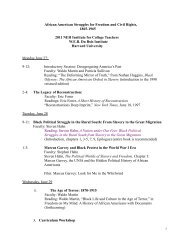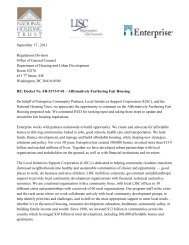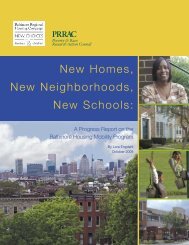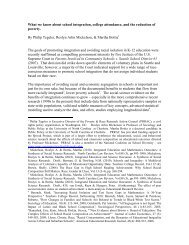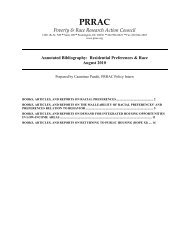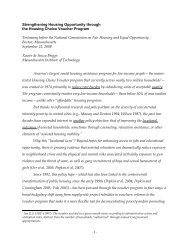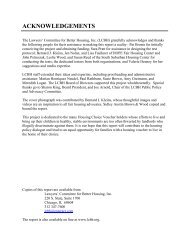Annotated Bibliography of Housing Mobility Research 2006-2010
Annotated Bibliography of Housing Mobility Research 2006-2010
Annotated Bibliography of Housing Mobility Research 2006-2010
You also want an ePaper? Increase the reach of your titles
YUMPU automatically turns print PDFs into web optimized ePapers that Google loves.
<strong>Housing</strong> Choice Voucher Families in Chicago (<strong>2010</strong>). Available at:<br />
http://www.housingactionil.org/downloads/IHARP_HCV_Report_<strong>2010</strong>.pdf<br />
Highlights:<br />
Abstract:<br />
· Found racial segregation <strong>of</strong> HCV holders increased from 1998, with most voucher holders<br />
living in communities that are more than 60% African American and above the city poverty level<br />
· Defines housing choice more broadly than just race or poverty but in terms <strong>of</strong> community<br />
"health," including environmental health, crime exposure, transportation, and housing stability<br />
· Argues for changes that will proactively create more communities within the city <strong>of</strong> Chicago<br />
that are healthy for voucher users as well as the people who live there without housing assistance<br />
Discusses role <strong>of</strong> HCVP in segregation patterns in Chicago. Findings from an analysis <strong>of</strong> the<br />
Chicago HCVP reveal that most voucher holders were living in predominantly African American<br />
neighborhoods on the south and west sides <strong>of</strong> Chicago with nearly half living in just 10 <strong>of</strong> the 77<br />
community areas in Chicago, which demonstrates and increase in racial segregation from 1998.<br />
Reviews results <strong>of</strong> the Gautreaux Program, the Moving to Opportunity program, the Latinos<br />
United consent decree, Chicago <strong>Housing</strong> Authority Plan for transformation (under Moving to<br />
Work), and the Wallace case; all programs had mixed results. Argues that "choice" should be<br />
looked at not only in terms <strong>of</strong> race and poverty levels, but more broadly in terms <strong>of</strong> "health":<br />
environmental health risks, exposure to crime, transportation, and housing stability.<br />
Recommendations for systemic improvement include partnership between Chicago HA and<br />
mobility housing counseling agency to promote opportunity moves, an information campaign<br />
about HCVP, outreach to underserved groups (including Latinos), incentives for landlords in highopportunity<br />
area (including increased payment standards and exception rents), more targeted<br />
FMRs, use <strong>of</strong> flexibility under the Moving to Work program to promote mobility, and enactment<br />
<strong>of</strong> source <strong>of</strong> income protections.<br />
Julian, Elizabeth K. & Demetria L. McCain, “<strong>Housing</strong> <strong>Mobility</strong>: A Civil Right,” in The<br />
Integration Debate: Competing Futures For American Cities (Chester Hartman & Gregory<br />
Squires, eds.), New York: Routledge, pp. 8598 (2009)<br />
Summary: Argues for Congress to enforce nonsegregation <strong>of</strong> federallyfunded housing assistance by<br />
promoting housing mobility<br />
Highlights:<br />
· Defines housing mobility as the right <strong>of</strong> lowincome people <strong>of</strong> color not to be limited to<br />
predominately minority communities as a condition <strong>of</strong> receiving federal housing assistance<br />
· Urges lowincome housing advocates to promote and remove barriers to housing mobility into<br />
whiter and higheropportunity neighborhoods for tenants who choose them<br />
· Details efforts <strong>of</strong> the Inclusive Communities Project in Dallas.<br />
Keels, Micere, Greg Duncan, Stephanie DeLuca, Ruby Mendenhall, & James Rosenbaum,<br />
“Fifteen years later: Can residential mobility programs provide a longterm escape from<br />
neighborhood segregation, crime and poverty”, Demography 42(1): 5173 (2005)<br />
Abstract:<br />
Examines whether the Gautreaux residential mobility program, which moved poor black volunteer<br />
families who were living in innercity Chicago into moreaffluent and integrated neighborhoods,<br />
produced longrun improvements in the neighborhood environments <strong>of</strong> the participants. Finds that<br />
although all the participants moved in the 6 to 22 years since their initial placements, they<br />
continued to reside in neighborhoods with income levels that matched those <strong>of</strong> their placement<br />
neighborhoods. Families who were placed in higherincome, mostly white neighborhoods were<br />
currently living in the mostaffluent neighborhoods. Families who were placed in lowercrime and<br />
suburban locations were most likely to reside in lowcrime neighborhoods years later.<br />
Keels, Micere, “Residential attainment <strong>of</strong> nowadult Gautreaux children: do they gain, hold or<br />
12





